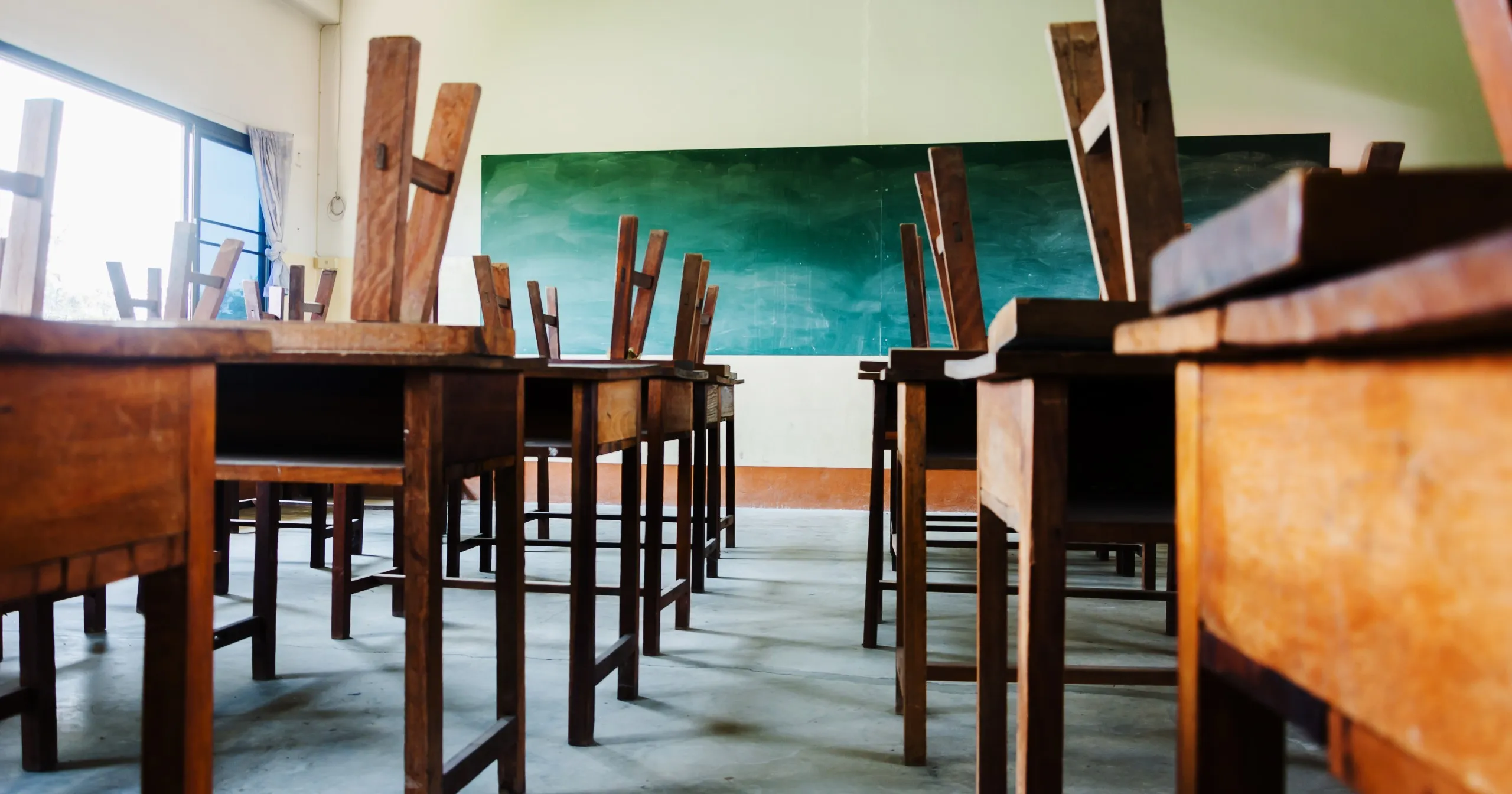
Spoken word artist Prince Ea showed his audience a photo comparison of two classrooms: one from 150 years ago and one from the present day. Interestingly enough, the photos are almost identical, except one’s in color.
In his compelling speech, Prince Ea reveals that our education system is modeled after Industrial revolution ideas—a model originally intended to raise factory workers trained to “sit in straight rows, nice and neat; tell them ‘sit still, raise your hand if you want to speak’; give them a short break to eat and for 8 hours a day tell them what to think.”
And if you think about it, he isn’t completely wrong.
But, is our modern-day classroom really based on a model from the 1700 & 1800s? And if it is, what needs to change?
There’s no doubt about it: the 19th century nurtured many new philosophies, ideas, and practices that heavily influenced education, many that persist today.
A lost objective
Some people believe that the American model of education is indeed stuck in the past. The present needs of our students are bursting the seams of an insufficient structure. In their view, we have lost the true objective of education as humanity has taken a deep dive into a sea of possibility, knowledge, and capability—leaving society’s youngest members in its wake gasping for air as their education system tries to keep up.
The Noah Webster Educational Foundation conducted an interview with Paul Lott—veteran, author, and founder of the NSABA—who says, “Today’s system is designed for something in the past, it doesn’t allow for personalization in education…the education system was designed with an objective and a goal. It didn’t want to create a critical thinker, it didn’t want to take on the responsibility of being a tool of personal fulfillment—its goal was to enable the average citizen to have a minimal level of literacy to function in the society of that time.”
His historical references describe an education structure built around significantly less content. Keeping that rigid format today suffocates students because the pure scale of information that children must absorb and learn today is massive by comparison. And the society they must grow up to join is much, much different.
“We call it a waterfall, right? Lesson, lesson, lesson, quiz; lesson, lesson, quiz; test… you know. Start over again, average out the scores and keep moving. In those days, you had a small body of knowledge that you had to transform. So you had time for repetition, a discussion about it, and kind of recycling and going through it so that—it wasn’t a lot—but you could learn it well, right? Today, we have a lot more that we’re trying to have them learn,” Lott says.
Invented History?
To further explore this issue, I Googled “School and the Industrial Age.” One out of the 10 results on the first page disagreed with the idea that modern education is still operating within an old Industrial-era framework.
Audrey Watters for Hack Education says, “One of the most common ways to criticize our current system of education is to suggest that it’s based on a ‘factory model.’ An alternative condemnation: ‘industrial era.’ The implication is the same: schools are woefully outmoded.”
Watters cites a video by Khan Academy that gives a summarized history of education throughout Europe and America and how it’s evolved since the 1800s. She claims that “Khan’s story bears many of the markers of the invented history of the ‘factory model of education’ – buckets, assembly lines, age-based cohorts, whole class instruction, standardization, Prussia, Horace Mann, and a system that has not changed in 120 years.”
Invented history? Hold on…what does Prussia have to do with school? And who’s Horace Mann?
Most importantly, whose interpretation of history is correct?
The Prussian Model
Watters’ mention of Prussia references the Prussian Model of Education. This model (built in part upon the ideas of Philosopher Johann Gottlieb Fichte) was set in motion by King Frederick the Great, according to educator Sptphen Davis. “Frederick’s primary goal was to build a productive and obedient working class by creating an educational system that would produce competent factory workers, but not free thinkers and innovators (that was to remain in the province of the aristocracy).”
Frederick’s vision was to create a world-leading society of military power and economic success. In the process, he introduced an education model that would end up influencing America’s education goals of “reduced illiteracy; compulsory tax-funded public schools; prescribed curriculum and discrete subjects; national testing; science and technology emphasis; teacher training and certification; teacher salary systems; strengthened national identity and respect for authority; secular instruction (religion taught only as subject matter); efficiently run schools; and students tracked by vocational and academic aptitudes.”
So how does the Prussian Model connect with the influence of the factory model/industrial era educational framework?
Horace Mann Enters the Scene
Mann was born in Massachusetts at the end of the 1700s, during the industrial era. He grew up to be an education reformer and eventually a member of the first Board of Education that was established in Massachusetts.
He believed that political stability and social harmony depended on “a basic level of literacy and the inculcation of common public ideas.” He “traveled to Europe to study the Prussian model of public education” and brought back ideas for U.S. education reform.
Motivated by these new findings, he launched the common school movement. Lumen Learning explains, “A ‘common school’ was a public, often one-roomed school in the United States or Canada in the 1800s. The term was coined by Horace Mann and refers to the school’s aim to serve individuals of all social classes and religions. Students often went to the common school from ages six to fourteen (predecessor of grades 1-8).”
Britannica calls Mann “the first great American advocate of public education.” Education site Wonderopolis, established by the National Center for Families Learning, credits Mann with developing “our modern version of the school system.”
What is Audrey Watters saying?
Clearly, the Prussian Model and Horace Mann have influenced American education. So why do some people—like Hack Education’s Audrey Watters—take issue with lumping the history together and calling it “the factory model” or “industrial era model” of education?
From Watters’ point of view, “[these terms] are used as a ‘rhetorical foil’ in order to make a particular political point – not so much to explain the history of education, as to try to shape its future.”
But for Lott and others who refer back to the “industrial model of education,” the historical nature of the topic is the point.
History doesn’t happen in a vacuum. Ideas that developed during the industrial era influenced how public education was modeled then…and those impacts haven’t disappeared. Components of that history linger in education today, holding students back from reaching their full potential in our modern society
Education Reform No Matter What
While we work to determine what changes the education system needs, “our objective…cannot be to just become more educated. And that’s where we are. And that’s where we’re running into problems. We’re educating to become more educated,” says Lott.
According to an article by Joel Rose for The Atlantic, “Today our collective vision for education is broader, our nation is more complex and diverse, and our technical capabilities are more powerful.”
Because our system is based on an old model, “our collective charge in K-12 innovation today should go beyond merely designing and producing new tools. Rather, our focus should primarily be to design new classroom models that take advantage of what these tools can do. New classroom delivery models allow us to re-imagine new combinations of educator expertise, time, instructional materials, research, physical space, parental support, and (yes) technology in ways that achieve optimal outcomes for students,” concludes Rose.
While the past deserves our attention and study, it’s essential for us to recognize the areas of our society that have evolved beyond their original framework designed a few centuries ago.
When it comes to enacting reform of todays’ educational model, what’s best for students? What parts of our system should be kept and what should be reimagined? What human needs and truths have endured throughout the centuries—and which of our modern needs require modern solutions?
What do you think? Is America’s education model outdated?
Visit the Noah Webster Educational Foundation to explore more education news and resources! Click here to watch the full interview with Paul Lott.
Did you know? You can collaborate with us! At the NWEF we’re always open to hearing your education story or welcoming new volunteers. For more information, send us an email at info@nwef.org.




